The Lowdown
All in all, Marvel’s Spider-Man: Miles Morales can be summed up in the following two questions. Was it fun? Yeah. Did it do enough? No.
Overall
Pros
- Fast-paced movement that never feels out of your control
- Venom superpower is a nice addition
- Some great characters I thought were well-written and acted
Cons
- It comes off too much like a re-skin of the first game
- Not a lot of content for the price
We’re back with another Marvel game, howdy, howdy, howdy. Marvel’s Spider-Man: Miles Morales was on sale recently, and I enjoyed the original immensely, so I felt it would be good to give this game a whirl. Instead of playing as Peter Parker, however, you are playing as the newcomer Miles Morales, the hero of Harlem. While the game borrows a fair amount from the previous Spider-Man game, it does bring enough new to make the experience interesting.
I beat the main story in about 8 hours; here are my thoughts.

So right off the bat, I don’t know a damn thing about Miles Morales as a character. I know there have been a few movies recently that have focused on his story, but I haven’t had the chance to watch them yet.
Going in blind, however, I liked him as a character more than Peter Parker.
Parker’s story as Spider-Man has been told and retold three times in mainstream cinema during my lifetime, and I find him very played out. We get it; he’s a spunky guy from Queens who has a pathological need to make bad dad jokes.
On the other hand, Miles comes off as a breath of fresh air, slowly developing his standing amongst the people of New York City, especially his home in Harlem.
Wait, So How Does Miles Morales Become a Second Spider-Man?
Miles’s origin as Spider-Man can be traced to the previous game, Marvel’s Spider-Man Remastered, where his father is killed while giving a speech by a gang called the Demons.
Later, Miles is bitten by a radioactive spider (sound familiar?), and he begins to develop superhuman abilities.
Miles eventually comes to Peter with this secret, and Peter subsequently reveals his. Talk about timing, am I right?
Taking Miles under his wing, Peter has trained him into a competent fighting machine.
What’s Going on in Marvel’s Spider-Man: Miles Morales
In Marvel’s Spider-Man: Miles Morales, a faction called the Underground has been stirring up a ruckus against this clean energy company, Roxxon.
Roxxon has developed a new reactor powered by an energy source called Nuform, but if their slimy CEO is anything to go by, they are certainly up to something bad.
It turns out Roxxon’s Nuform actually causes people to get sick, and upon realizing this, the substance’s creator, Rick, and his little sister, Phin, seek to uncover Roxxon’s crimes; because, you know, the corporations couldn’t care less as long as their stock price goes up.
Rick is subsequently killed while trying to shut down his own clean energy reactor (being done in by one’s own creation is quite poetic if you think about it), as his sister Phin is watching, unable to rescue him.
It is revealed that the Underground gang has been able to be so good at dismantling and disrupting Roxxon’s operations because Phin has been trading them advanced weapon designs and gear for their help in her crusade against Roxxon. It turns out she’s quite the genius.
FURTHER complicating things, Phin is Miles’ childhood friend, and they spent most of their formative years together. This not only means, on a personal level, they will butt heads over what’s considered “justified,” but his alter ego will also inevitably clash with her as well.
What a pickle.
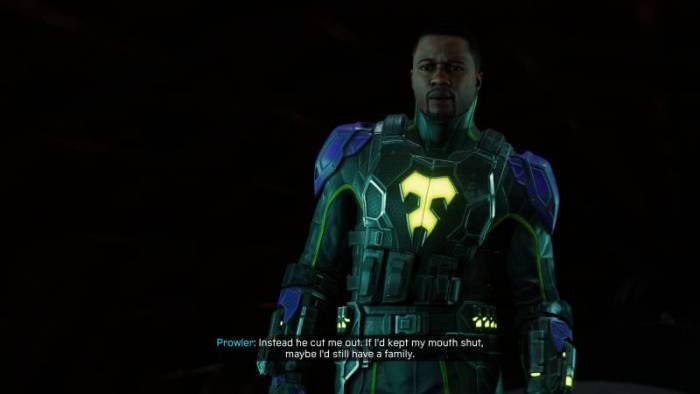
Somehow, Miles’ estranged Uncle, Aaron Davis, has deduced his secret identity; it is also revealed that Uncle Aaron moonlights as a mercenary/thief called the Prowler.
It seems like everyone has a part-time job these days, so I get it. It makes for a bit of a headscratcher to explain, but we’ll get through it.
Uncle Aaron begins to advise Miles on how to stop the Underground and suggests that Miles try to gain an inside track on the gang’s activities by convincing Phin that he wants to join her little terrorist cell.
This obviously goes poorly; when Phin finds out that not only did Miles try to use her for access but that he is also Spider-Man, she understandably goes ballistic, and she turns a deaf ear to any attempts to dissuade her from her plans.
Using intel from the Prowler, naively given because he thought the slimy CEO would honor their agreement with him not to mess around with or capture his nephew, Roxxon kidnaps Miles and Phin and locks them in a fortified facility.
Perhaps Aaron, this consistent lack of judgment is why your brother cut you out of his life in the first place? Just a thought.
Miles and Phin make their escape by punching the daylights out of everyone in front of them, but it’s clear that a war is about to break out on all fronts. The Underground has something big planned, Roxxon is now on the attack, the Prowler is a dirty snake, and Miles is caught in the middle with the people of NYC at stake.
Before all the chaos begins, Prowler combines a familial concern for his nephew’s safety with a dubious moral compass and captures Miles in order to lock him away and make sure that he survives the battle to come.
This ultimately culminates in a brutal slug match between the two family members, leaving Aaron questioning every decision he has ever made.
Throughout his investigations, Spider-Man II has discovered that due to losing almost all viable Nuform sources and having killed the creator of the miraculous substance, Roxxon has dangerously amended the specifications of their reactors so that the project timeline can be accelerated.
Phin is unaware of this, and with her plan being to singularly blow up Roxxon headquarters, the modifications Roxxon has made to the reactor may actually destroy ALL of Harlem! It would probably also take out some of the Bronx and Queens too, but apparently, this game doesn’t think they exist, so we won’t worry about them.
Miles defeats Phin, as pleading with her to stop before killing millions of people does not sway her. However, she has already supercharged the Nuform reactor, which is starting to go critical.
Miles manages to absorb the reactor’s energy into himself and successfully decommissions the device. Unfortunately, he is not strong enough to contain the apocalyptic energies held within. When he inevitably lets go, he will still bring the same untold death and destruction he has been trying to avoid.
In a moment of clarity and regret, Phin flies him into the sky for him, dooming herself but saving everyone else. Miles unleashes the power and evaporates Phin in an instant.
It’s a slightly cookie-cutter story, but I thought it was pretty great.
Marvel’s Spider-Man: Miles Morales does an awesome job of making you, the player, feel like you’re not only slowly gaining trust in yourself as a protector but also within the community as well.
Miles’s friend Ganke develops an app that the residents of Harlem can download and use to request everything from rescuing a lost cat to taking a selfie with the young hero.
As you complete the residents’ requests, the folks you see on the street start to treat you more with reverence and love, as opposed to confusion about who the hell this new Spider-Man is.
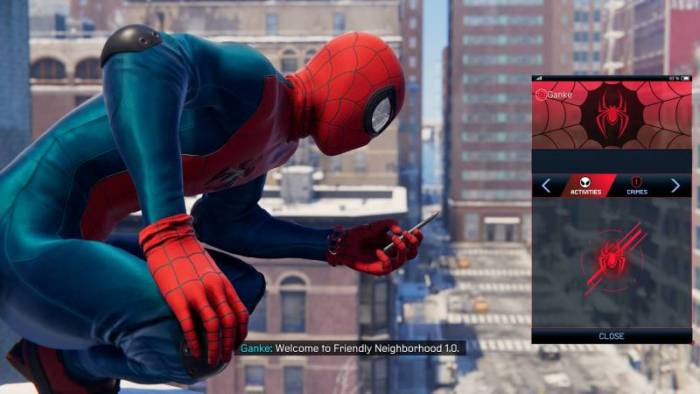
This culminates at the end of the story, where a handful of Harlem residents (some of whom you have directly helped in your playthrough) see Miles unmasked.
A reporting crew rushes to the scene, and instead of being focused on what happened or the heroics of a young man shouldering limitless responsibilities, the crew 0nly care about who is behind the mask.
They probe the Harlem residents vigorously, but the people just look at each other and resolutely proclaim, “he’s our Spider-Man.”
End credits.
Boom.
I felt this was meaningful.
These subtle interactions between various characters made me much more interested in the story than I thought I would be.
For example, Phin and Miles’ precarious dance around each other’s identities was short but powerful, and the voice actor for Phin did an amazing job at conveying betrayal and her rage all at once in their climactic fight.
While admittedly cheesy, the sacrifice Phin makes at the end, as she realizes what she almost did, was very heroic.
While sad, I thought it was a redeeming end to a tragic life.
Likewise, Miles’s mother genuinely made me almost tear up a few times with how she carried herself and the things she said.
I’m a huge fan of strong female characters, and while her screen time is minimal, the writers did an amazing job portraying her as a stalwart ally of the community, the greater good, and of Miles himself.
After a huge fight, Miles got himself into, Mom discovers him in costume, badly bruised, in their apartment; I fully expected a bollocking.
However, she listens to him, understands why he goes out there and risks his life, and sums it up that Miles gives her strength to do what she does and that he reminds her of his father more every day.
Despite all the danger and all the potential pain, Miles’s mother knows he’s doing this because he cares for others and wants to do everything within his considerable power to make a better tomorrow, just like she is.
Sniff Sniff
All in all, it’s a good hang; I really enjoyed the journey.

OK, Stop Sobbing, You Putz; Get to the Action!
Simmer down, dork. If you’ve come directly from playing Marvel’s Spider-Man, you may be a tad disappointed as there isn’t that much reinventing going on. You’re still swinging around Manhattan, beating up on gangs and accomplishing little trivia hunt activities marked by colorful circles across the map.
“Punching people?!” I hear you shriek. “Tell us more!”
Well, for starters, as Miles, you have fewer gadgets to play around with than Peter Parker does, but the core four Miles has access to are pretty handy in a pinch.
- You have your basic web shooters that can adhere people to surfaces if they’re close enough.
- You have the ability to create holographic decoys that don’t do that much but can still distract someone trying to shoot at you.
- You can lay landmines, which, if placed on specific power outlets, will shock a group that meanders into their sphere of influence.
- Finally, the gravity well yanks enemies together and pulls their weapons out of their hands.
As there are fewer “supervillains” in this game to fight, you mostly lay the beat stick down on humans, and to make them more difficult, the game introduces them with additional weapons and toys, so using your gear to thin the herd prior to jumping into the fray may be advisable.
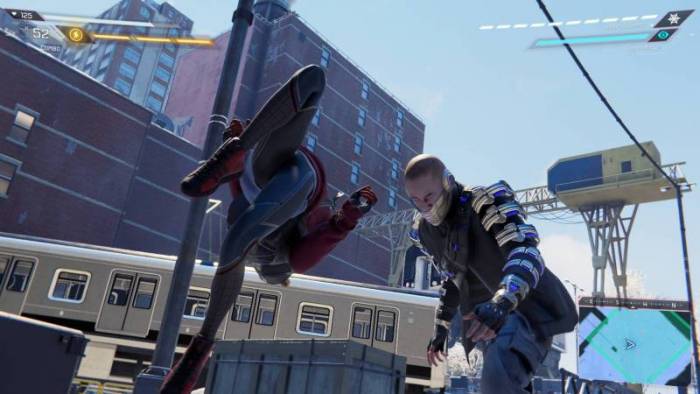
Marvel’s Spider-Man: Miles Morales handles pretty well in terms of speed when it comes to fighting thugs. There were some hitches where Miles would get caught on the scenery as he leaped around, but I found the combat system quite fluid.
He can yank enemies up into the air, pull them to the ground, yeet off a wall, and propel himself into someone’s spine.
If there is an angle at which Spider-Man can connect his appendages to someone’s fleshy bits, he will find it.
Key to his “super evasive and annoying” style of combat, Miles possesses the original’s Spider-Sense.
Upon being targeted by an attack, Miles’ head will flash, and this is your cue to have him dodge out of the way quickly. When the icons flash red for a brief instance, that means you’re about to be pancaked by whatever is coming your way, so dodging in that window makes it a “perfect dodge.”
The advantage is that you can automatically web-up a non-miniboss attacker when you dodge in that sweet spot, taking them out of the action temporarily.
However, the new addition to the combat repertoire is something called “venom,” which is basically a form of bioelectricity.
Miles is able to discharge venom in numerous ways. This bioelectricity can arc to other enemies in the area; it is generally considered a really good idea when it comes to crowd control or loosening the hold a roided-up enemy may have on you.
My favorite usage of venom is to leap into the air while using the bioelectricity’s tendrils to elevate everyone in my immediate area up to my level. While they are stunned and floating, you are free to pummel them with impunity, all the while generating additional charge and dealing additional damage.
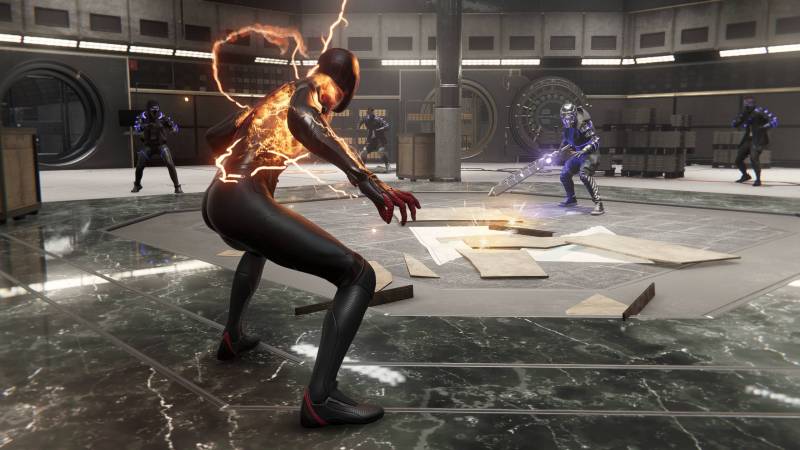
Venom truly is a versatile facet that expands your skillset, and I like that they made Miles handle it differently enough from Peter.
When not punching the daylights out of people, you are free to explore Manhattan using your webbery and spider-like agility.
As with the first Spider-Man game, there is something so spectacular about swinging through Manhattan at breakneck speed. They’ve tweaked the scale of Miles compared to the buildings around him so that no matter how fast you go, it never really feels like you’re careening out of control.
However, this sense of freedom and precision doesn’t quite make it to interior spaces.
In some missions, you are tasked with infiltrating enemy bases and/or fortifications.
There are often gangways and walkways that soldiers from various gang factions like to snipe you from, and I’ve found that you get stuck on some invisible barrier every now and then, which diminishes the free-wheeling movement that you could argue defines this series.
I do not recall this happening in the first game, but either way, it’s a small gripe.
Overall it’s really polished, so that’s a definite plus.
On the subject of infiltrations, one additional thing to note is that Miles’s skillset has a huge stealth component that can be quite entertaining if one has the patience.
Distracting enemies allows you to web them up from the walls, platforms, or ceiling and truss them up like little marionettes. It is even possible to clear out an entire room with nary a soul noticing if you’re careful and patient enough.
Miles also can camouflage with his surroundings for short periods to set up an ambush or get out of a jam.

Sleep tight, my little turkeys.
Another clear improvement is that they minimalize Miles’s time wandering outside his Spider Suit.
If you’ve read my previous review, I criticized the game for forcing you to take time doing stealth or investigation missions as Mary Jane or pre-superpowered Miles (ironically enough).
These were typically used to shake up the narrative flow a little by introducing a feeling of vulnerability, which in a vacuum is fine, but they didn’t work in a fast-paced superhero setting.
Yes, it’s good to know that Peter Parker has allies he can trust to risk their lives for him, and yes, the human spirit is commendable, but that’s not what that game needed.
On the other hand, Marvel’s Spider-Man: Miles Morales kept it truncated.
There are a few scenes here and there demonstrating Miles’s connection to his family and friends, and a small section or two teaching him a valuable skill he can use in the environment was a pretty good balance, in my opinion.
What helps is that you will always play Miles, so even when he’s in street clothes, you don’t get that feeling of disconnect with the character the game is trying to immerse you into.
In short, I think they’ve done away with a lot of pointless filler in this game, so that’s a positive in my book.

I’m fine with the moments that build the plot rather than needless stealth missions and investigations.
So Why Is Marvel’s Spider-Man: Miles Morales Good but Not Great?
The Miles Morales experience is a very solid one, and I don’t feel like I wasted my time here, but there are two main things that irk me and prevent this from being outstanding.
Quite simply, the length of this game is a problem, and the lack of any new content is whack.
The first issue is exactly as it seems on the tin.
I had read that this game was shorter than the previous edition, but I went in without any spoilers and kept track of the time it would take me to complete the objectives.
I finished the main story (with some copious detouring, I might add) in just about 8 to 9 hours into the playthrough. After beating the main story, I proceeded to clear the entire map of activity icons (more on that in a bit). I 100%’ed the map at maybe the 12-hour mark.
To be clear, this means in my first playthrough; I did all the side missions/main missions/and miscellaneous content by the 12-hour mark.
Upon finishing playthrough 1, I glanced at my achievements on Steam and noticed that it would be very easy to achieve them all because, really, the only one that would take a little time would be to beat the game in “New Game+.”
For those who don’t know, “New Game+” is a mode where upon beating certain games, you’re able to start a brand new playthrough with the equipment/skills you’ve already attained.
So, seeing as I have no social life, I decided to give it a shot; I’m now at the 19-hour mark and have accomplished everything this game has to offer.
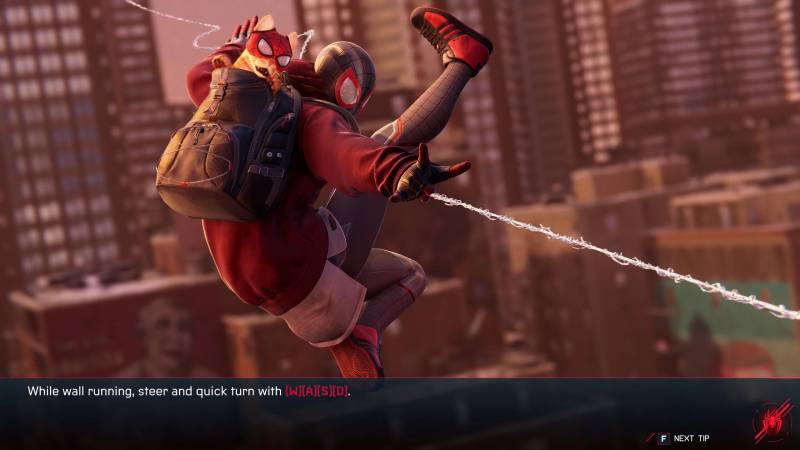
This is an actual outfit; by the way, it’s incredible.
Without even 20 hours of playtime, Marvel’s Spider-Man: Miles Morales sits in my Steam Library with a little blue ribbon as a “perfect game,” with 50/50 achievements attained by yours truly.
I didn’t beeline from objective to objective; I failed a side mission here and there, I got lost in the scenery every once in a while, and it still chalked up to that amount of time.
As alluded to above, the content that you can spend this time engaging with is divided into main missions, side quests, and miscellaneous activity icons.
Side quests were largely fine and focused on cleaning out the Kingpin’s (mob boss) crew from Harlem.
The fat Cueball has decided to prey on economically disadvantaged people, mom-and-pop store owners, and the average working man, and considering this mofo has a building with his name on it in this version of Manhattan, it was all the more fun to dismantle his operation. Eat the rich.
Anyway, the storyline is cute and succinct, and you get to feel fuzzy about building up your relationship with the community. Side missions are done.
Then come the activity icons.
These are scattered all around Manhattan and function as points of interest where Miles has to complete a certain task or scrounge a collectible.
The weirder ones can be something like identifying a piece of the environment that’s emitting a certain sound so you can record it to complete your late father’s homemade mix tape (I’m not kidding).
The simpler ones can be grabbing a piece of paraphernalia from your past, like this monstrosity below.
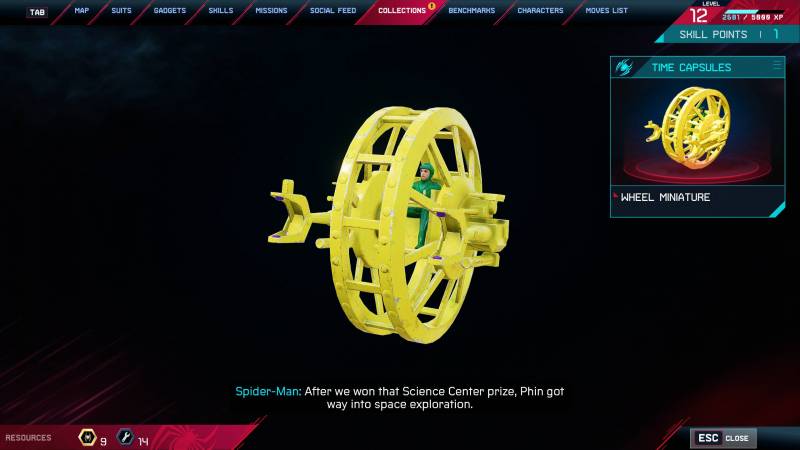
This might as well be a war crime.
Some of the activities are stopping a crime; some are locating a technology cache so you can upgrade your shit; some are completing an augmented reality training session, yadda, yadda.
The point I’m trying to make is that, by and large, these are busy work, through and through.
They require very little brainpower, and in fact, the only ones I actually enjoyed were finding a series of postcards Miles’s mother leaves around town that provide cryptic hints to locating the next one. Basically, it’s a scavenger hunt (I love those).
However, you don’t even get to do this activity until AFTER you finish the game, meaning up until then, everything else is steeped with mediocrity.
What’s even more hilarious is that while there are a solid amount of main missions in the campaign, if you look at them quickly, a significant portion of them are merely a means to introduce adding additional activity icons to your map.
For example, (because I know you’re wondering) let’s talk about the mixtape.
Uncle Aaron, as the Prowler, invites you out to the docks and tells you this story about how he and Miles’ Dad were originally super close and wanted to make music using the sound of the city as elements in the backtrack.
Mile’s task is to go to specific locations and, after hearing the original mp3 segment, find what is generating the sound in the nearby environment.
The round trip outside of cutscenes for this mission: 30 seconds. Completing it causes a bunch of icons to pop up on your map, leading you to more sounds, and boom, that’s one of the 17 main missions down.
In 30 seconds, you’ve completed 6% of Mile’s journey.
Oh, not enough? Here’s another whack at the nutsack.
In a mission that’s basically an entire cutscene in and out of memory lane, you and Phin discover “Time Capsules” that contain junk from your past. Consider the above yellow deformed wheel with a tiny green gremlin inside of it Exhibit A.
Time out of cutscene: Negligible. One of 17 activities down. Another 6%.
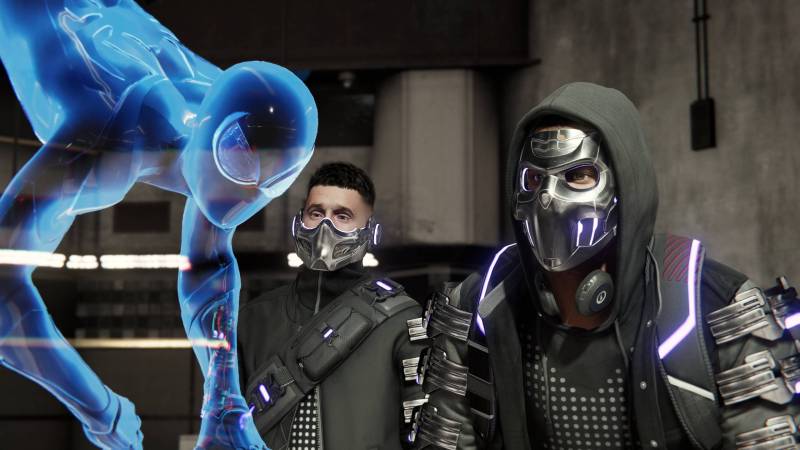
I know, fellas; I had the same expression.
While the zipping around, the punching, the setting, and the narrative are by and large pretty good, a lot of elements were copied from the previous game. While I know it’s part of a series, and they’ve taken good things, there simply seems to be an imbalance of new content that’s got any depth and/or novelty to it.
Main missions can fly by before you know you’ve finished them, and then you’re largely left with sweeping the map, popping the colorful activities icons along the way. Even when a main mission was longer, it would still be a similar format of: “infiltrate here,” “punch these guys,” or “analyze the evidence.”
If you sum up these two issues with the fact that at full price, Marvel’s Spider-Man: Miles Morales is $50 without sales tax, you likely understand what my problem is.
They’re charging you the price of a whole pork roast while delivering an Oscar Meyer Weiner to the table.
Maybe I’m hungry…but you get the drift.
I’ve often written that some games just cram too much meaningless filler into their worlds in an effort to tack on additional hours to your playtime, trying to paint the illusion of a full-fledged experience.
This one pendulumed back in the other direction, but it didn’t add enough new stuff to make it notable.
Honestly, I wouldn’t even have bought it if it wasn’t on sale.

Should You Buy Marvel’s Spider-Man: Miles Morales?
All in all, Marvel’s Spider-Man: Miles Morales can be summed up in the following two questions. Was it fun? Yeah. Did it do enough? No.
It’s my shortest conclusion to date, but what more needs to be said really? That’s why this game gets a 3.5/5
Definitely buy it on sale because if you buy it at full price, you’ll be a little disappointed. If you see it around $20-25, I think it’s acceptable.
Marvel’s Spider-Man: Miles Morales sells for $49.99: it is available from Steam and PlayStation.
Developer: Insomniac Games
Producer: Playstation PC LLC
Source: Personal purchase
What I Like: Fast-paced movement that never feels out of your control; Venom superpower is a nice addition; Some great characters I thought were well-written and acted
What Needs Improvement: It comes off too much like a re-skin of the first game; Not a lot of content for the price

Be the first to comment on "Marvel’s Spider-Man: Miles Morales Review: A Chip Off the Old Block"